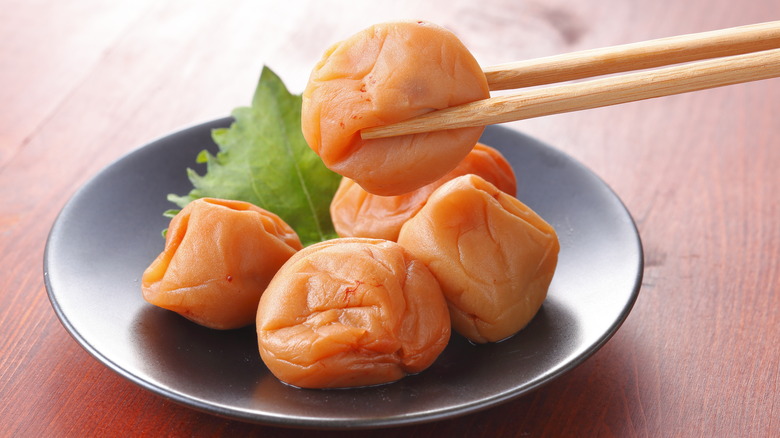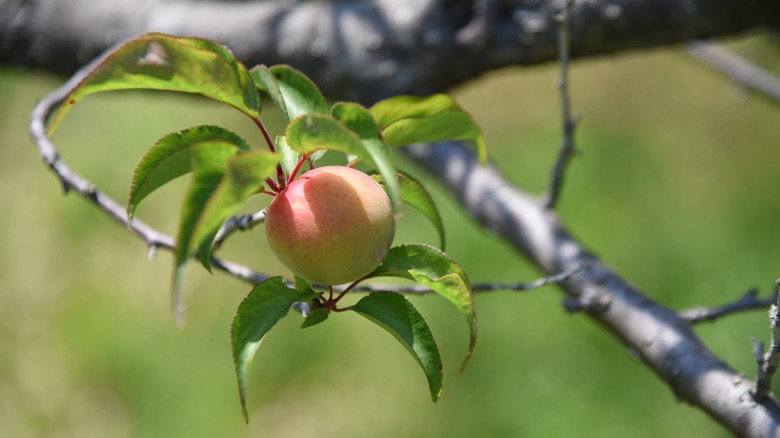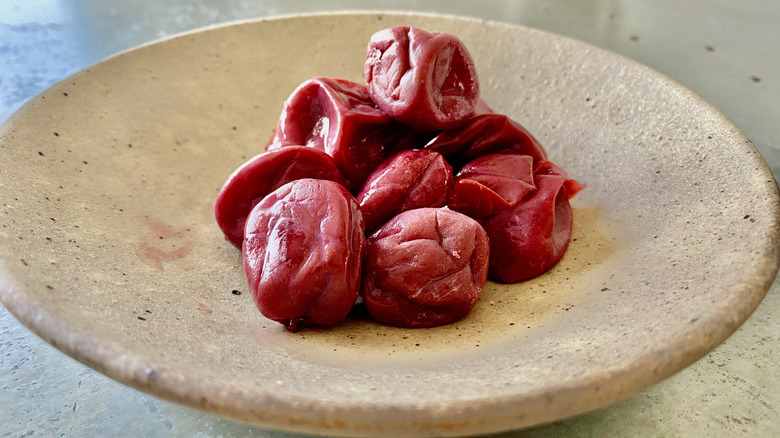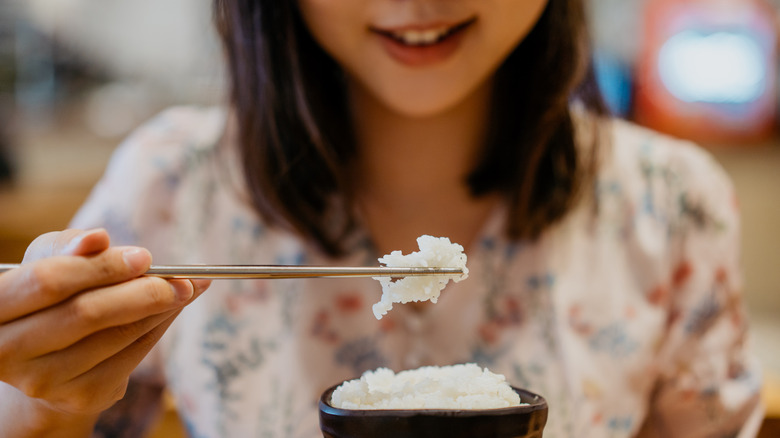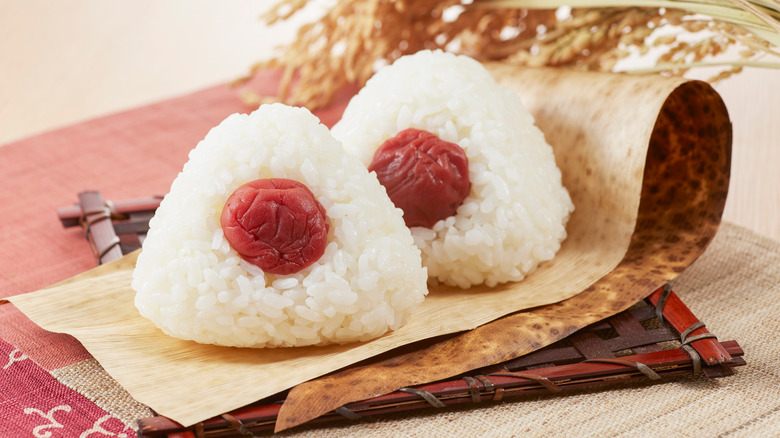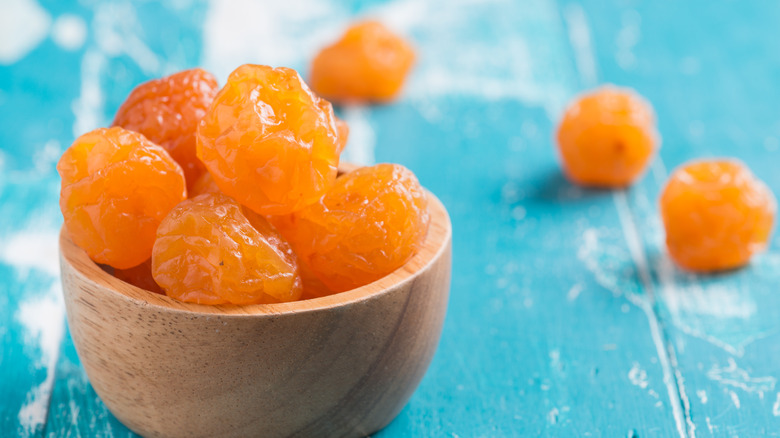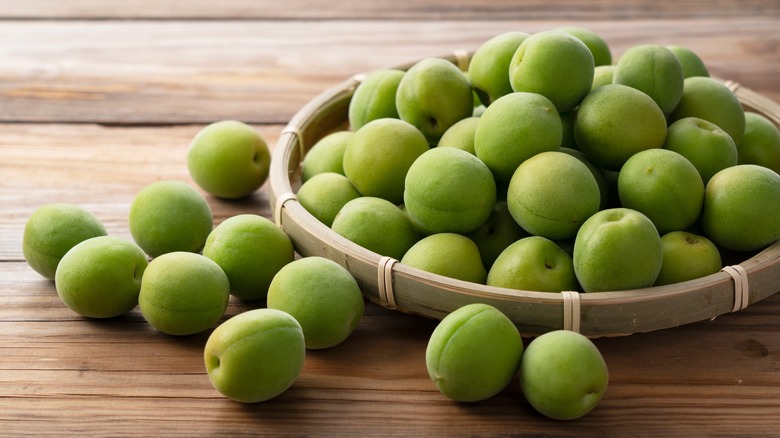Umeboshi: Everything You Need To Know About The Tangy Japanese Fruit
The distinct flavors of Japanese cuisine appeal to many people – not just for its diversity and notable health benefits, but also for the way it incorporates bold, standout ingredients like umeboshi. This pickled, salted plum introduces a vibrant burst to the rich tapestry of Japanese flavors, with its distinctive sour taste complementing the cuisine's fresh, nutrient-rich, and low-fat natural ingredients.
As one of the signature and star ingredients of the beloved onigiri dish — the delightful Japanese rice balls wrapped in seaweed — umeboshi offers a distinct flavor that sets it apart, embodying Japan's long tradition of fermented foods. Though central to Japanese culture, this humble pickled plum is more than just a palate-pleaser; it transcends its culinary boundaries to become a symbol of tradition.
Today, chefs and food enthusiasts have found new ways to experiment with umeboshi, incorporating it into modern culinary trends through glazes, sauces, and even desserts. Exploring umeboshi broadens your taste buds and deepens your appreciation for its cultural and culinary significance. But don't just take our word for it. Read on to understand what makes the unique umeboshi a pretty excellent fermented food.
It's a fruit closer to apricots than plums
Even though it is frequently called a plum, this isn't the most accurate term for the Japanese fruit. Umeboshi is a pickled version of "ume," a fruit indigenous to East Asia that botanically belongs to the apricot-bearing tree species (Prunus mume). While it isn't incorrect to refer to them as umeboshi plums, the difference is nonetheless pivotal as it highlights the relationship between ume and apricots when we delve deeper into their botanical traits.
Physically similar to smaller, under-ripe apricots, ripe ume fruits are small, round, and feature fuzzy skin. But the confusion often arises from ume's transformation when pickled to become umeboshi. The pickling process gives ume intense sourness similar to unripe plums. This is a stark contrast with the sweet nature of an apricot, even when tart.
Scientific classification places ume in the Rosaceae family and Prunus genus, home to all your favorite stone fruits like peaches, cherries, and apricots. This shared ancestry underscores why the ume fruit — and, by extension, umeboshi — should be more accurately considered an apricot, even though it is referred to as a plum.
Umeboshi fruits have been eaten in Japan for centuries
This distinctively sour fruit has captivated Japanese taste buds for a long time, securing a venerable spot in Japan's culinary and cultural landscape for centuries. Originating from Central China about 1,500 years ago, umeboshi first gained recognition in Japan for its medicinal properties — used to ward off colds, treat wounds, and soothe stomach upset. Japan's oldest surviving medical text, the "Ishinhou" (compiled in the late 900s), chronicles the use of umeboshi for treating various ailments. This historical use as a health remedy laid the foundation for its transition to a culinary staple, and reflects the fruit's enduring and universal appeal.
Umeboshi's flavorful leap from the medicine cabinet onto the dinner table was born out of necessity; ancient Japan's lack of refrigeration technology led to the discovery that fermenting ume plums preserved them for days, intensifying their tangy flavor. These little powerhouses transcend their health benefits to embody resilience and perseverance, traits highly revered in Japanese culture. The culinary applications of these brine-preserved plums are diverse, from a key ingredient in onigiri to a flavor enhancer in savory dishes.
Historically, people even added umeboshi to hot green tea to create "fuku-cha," a lucky tea served during festive occasions such as New Year's Eve, which further highlights its cultural significance. This versatility underscores umeboshi's pivotal role in Japan's culinary tradition and social customs, maintaining its popularity through the ages. Today, Japanese culinary traditions continue to be a cherished element, even as younger generations are just beginning to explore what umeboshi has to offer.
Samurai warriors ate umeboshi to combat fatigue during the Muromachi period
Imagine fierce samurai warriors charging into battle, fueled not just by determination but also ... sour plums? As surprising as it may sound, the seemingly modest yet tart-tasting umeboshi played a crucial role in the diet of soldiers during the turbulent Muromachi period (around 1400 A.D.). These intensely sour plums — a natural fatigue fighter with many other health benefits — served as the warrior's secret weapon, providing a quick energy boost invaluable to samurai on prolonged campaigns. The salty and sour taste of the citric acid in pickled ume fruits stimulates saliva production, aiding digestion and preventing nausea — a common side effect of fatigue.
Citric acid also supports the Krebs cycle, a series of chemical reactions releasing stored energy in cells. For the samurai, consuming umeboshi meant increased energy levels, enhanced stamina, and sharper battle focus. But why umeboshi, of all things? Beyond its energy-boosting effects, umeboshi is also an electrolyte powerhouse, rich in potassium and sodium — a convenient, portable hydration source vital for warriors during intense physical exertion.
Given this context, the tangy, salt-preserved ume plum was both a superfood and a strategic asset, especially for the samurai warriors in maintaining their physical strength. This dual role of the umeboshi plum highlights a fascinating facet of traditional Japanese cuisine, where practical benefits seamlessly blend with nutritional value.
Umeboshi plums have anti-bacterial properties
While the iconic umeboshi packs a tangy flavor punch, few are aware of its potent anti-bacterial properties. These highly salted, pickled plums have been revered in Japan for more than their taste, with modern science beginning to validate the multifaceted health benefits that consumers have attested to. Traditionally, umeboshi plums have been a staple in Japanese medicine for centuries, preventing and treating various infections.
The secret to the tangy fruit's germ-fighting power lies in its unique combination of natural compounds. Umeboshi is rich in citric acid, a natural preservative known to halt the growth of harmful bacteria and viruses, effectively acting as a microbial shield in your body. But the health benefits don't stop there.
Salt-preserved ume plums contain numerous phenolic compounds, plant-based chemicals celebrated for their antimicrobial properties. These microscopic guys actively disrupt harmful bacteria cell walls, sending a stern "no entry" signal to pathogens responsible for severe foodborne illnesses. Simultaneously, fermented umeboshi plums are a high-fiber food, fostering the growth of beneficial gut flora, enhancing digestion, and having a positive impact on your overall well-being. Whether aiming to bolster your immune system, ward off bacteria, or simply enjoy a nutrient-packed superfood, the umeboshi plum is a delicious addition to your dietary regimen.
It's known to help balance the body's pH levels
Beyond providing energy, umeboshi plums also balance the body's pH levels, impacting everything from digestion to immunity. Imagine our bodies as intricate orchestras, with each instrument (organ) playing its part in harmony. In this biological symphony, pH levels, a measure of acidity or alkalinity, act as the conductor, ensuring our blood thrives in a slightly alkaline environment, around pH 7.4. But when things get too acidic, the delicate pH balance is thrown off, disrupting the performance.
Enter the highly alkaline umeboshi plums. Despite their tart taste, once digested they help neutralize excess acidity in the body, nudging your pH back toward its sweet spot. Our modern diets, loaded with processed foods and sugary drinks, often lean towards acidity — so incorporating umeboshi can counteract this imbalance. More importantly, the citric acid in these tangy treats neutralizes food alkalinity, helping the body absorb minerals and flush out fats and toxins that, if accumulated, contribute to an acidic environment in the body.
Beyond balancing pH levels, umeboshi's health benefits extend to reducing bloating and discomfort, sustaining energy levels, and boosting the immune system. Umeboshi plums are not just a treat for your palate; they're allies for your body, balancing its pH and supporting natural healing and disease prevention. Including them in your diet goes beyond culinary exploration — it's a move towards better health, showcasing their significant wellness benefits.
Umeboshi plums can help with stomach issues
Umeboshi's tangy flavor is undoubtedly appealing, but the impact of these sour gems extends well into the realm of gut health, potentially becoming your new go-to for digestive aid. With natural acids and probiotics, umeboshi offers a comprehensive natural remedy against stomach issues. The citric acid prevalent in these plums plays a crucial role in eliminating harmful bacteria in the gut while promoting the growth of beneficial microbes, ensuring a balanced and efficiently functioning digestive system.
According to the National Library of Medicine, umeboshi's compounds enhance gastric juice production, aiding in the stomach's breakdown of fats and carbohydrates. This process facilitates smoother digestion and mitigates symptoms like indigestion and bloating, helping to avoid that post-meal slump and providing a natural solution to common gastrointestinal discomforts.
Like yogurt and other fermented products, umeboshi's probiotic content is pivotal for gut health, improving digestion and fortifying the immune system. Its alkalizing property also counters stomach acidity, often the culprit behind indigestion. Incorporating umeboshi into your diet — whether as a tangy snack, a flavorful paste, or a zesty addition to meals — lets you tap into an age-old remedy with substantial scientific backing. It's a tasty, natural way to boost your digestion.
Japanese eat umeboshi plums as a hangover cure
Unlike the Western approach of turning to a Bloody Mary and greasy comfort foods to cure hangovers, Japan offers a contrasting remedy — the therapeutic properties of umeboshi. The shriveled plum's potent blend of citric acid, antioxidants, and essential minerals such as iron, manganese, and calcium make it an ideal — though humble — solution to the aftermath of alcohol consumption, showcasing umeboshi's multifaceted role in health and wellness.
Citric acid boosts energy metabolism and detoxification, easing hangover symptoms like fatigue and headaches. Simultaneously, the plum's alkalizing effect combats lactic and pyruvic acid present in alcoholic beverages. This scientific rationale is complemented by the plum's storied place in Japanese tradition, where it's consumed after a heavy night for its therapeutic benefits, mirroring a broader cultural appreciation for food's healing powers.
In a world increasingly drawn to synthetic solutions, the umeboshi plum stands out as a testament to the enduring power of natural remedies. Rooted in centuries-old traditions yet validated by modern science, these sour plums offer more than just a respite from the discomforts of overindulgence. Their integration into the fabric of Japanese culture highlights a profound respect for the symbiotic relationship between diet and wellness, a principle that resonates across borders.
Umeboshi is used to prevent rice from spoiling
Beyond countering alcohol's effects and its numerous health benefits, pickled ume fruit proves invaluable in preventing rice spoilage, showcasing umeboshi's versatility. Central to Japanese cuisine for centuries, this plum enhances rice preservation by being placed atop a steaming pot of rice in a cooking process known as umeboshi gohan. This preservation method infuses rice with a delicate, fruity aroma, enhancing its taste profile.
The magic lies in the molecular tango between rice starches and umeboshi's citric acid. The acidic quality of umeboshi combats bacterial growth, which is the real culprit behind rice spoilage. This tradition keeps rice fresh and appealing, leveraging natural ingredients for their preservative qualities and creating a uniquely Japanese rice experience. Adding umeboshi to steamed rice preserves it and imparts a subtle tang, transforming the staple grain into a nuanced culinary delight.
The blend of umeboshi's distinctive compounds with rice's distinct aroma molecules creates a strong and intense flavor profile, adding an instant umami kick (that coveted savory goodness) to the dish. The Japanese pickled plum is more than a taste enhancer; it embodies the ingenuity of traditional Japanese food preservation, reminding us that powerful culinary tools sometimes come in small, unexpected forms.
The Japanese pickled plum can be used as a filling for rice balls (onigiri)
Building upon umeboshi's rich flavor profile, the sour plum perfectly complements onigiri, one of Japan's most popular answers to portable snacks. This classic Japanese rice ball serves as a convenient on-the-go bite and a canvas for numerous flavors, among which umeboshi distinguishes itself as a traditional favorite. The onigiri-umeboshi pairing is steeped in Japanese culinary tradition, blending rice's simple, starchy sweetness with the intense sourness of the fermented ume fruits.
When nestled inside the rice ball's center, its reddish hue peeking through, the umeboshi plum imparts an appetizing zest that awakens the palate. This contrast enhances the overall eating experience, offering a burst of flavor with each bite. Additionally, you can temper umeboshi's tanginess with the vibrant purple hues of shiso leaves (Japanese basil or perilla leaves) to add an earthy shiso aroma to your rice ball dish. These attributes contribute to its popularity as a filling, adding a nutritious punch to the simple rice ball.
The preservation process of umeboshi also means these plums can last a long time, making them a staple in Japanese pantries and a reliable ingredient for onigiri. Using umeboshi in onigiri is more than a culinary choice; it's a nod to Japan's rich food culture. It combines the need for portable, easy-to-eat nourishment with the desire for food that is both flavorful and beneficial.
Honey umeboshi offers a unique taste experience
The salty taste of umeboshi is one of its defining traits, but there is a sweeter side and it comes in the form of honey umeboshi. Unlike the familiar pucker-inducing sourness and sharp saltiness of regular umeboshi, honey umeboshi introduces a novel sweetness that tempers the intensity, creating an enjoyable taste. Traditionally, a small amount of honey is added during the pickling process, resulting in a delicate balance between the familiar sourness of umeboshi and a subtle, almost floral sweetness.
The diversity of the salt-pickled ume fruit preparations allows for even more unique experiences such as the shiso umeboshi, ume plums wrapped in shiso leaves, adding a refreshing, minty layer. Consider onigiri, rice balls filled with honey umeboshi, a popular bento lunch option. Not forgetting the umeboshi paste, a concentrated blend of salted ume plums, perfect for adding a tangy kick to sauces and dips.
Umeboshi's influence is also evident in a variety of culinary applications. Chefs often incorporate a hint of honey umeboshi paste in salad dressings, like vinaigrettes, for a more nuanced depth. Glazing grilled fish or chicken with a honey umeboshi sauce creates a uniquely sweet, savory twist. Even cocktails aren't spared, as it adds a surprising layer of complexity to their profiles. The creation of honey umeboshi signifies the boundless diversity of umeboshi flavors and preparations, suggesting that this traditional Japanese fruit can be enjoyed in evolving and imaginative ways.
Ume fruits are harvested when still green and unripe
You might be thinking, surely ripe ume fruits are the holy grail? When it comes to umeboshi, however, that isn't the case. Plucking these little gems from the branches while they're still a vibrant shade of green and sporting their fresh, tart charm is a deliberate step to capture their peak potential. This timing is crucial for maximizing the citric acid content of the fruit.
An ume fruit, unlike your average stone fruit like peach, contains a boatload of citric acid when green, almost three times as much as a lemon — so harvesting them in this state retains the acid content at its highest. This sets the stage for their transformation process into the tangy delicacies we know as umeboshi.
Post-harvest, these green ume fruits are salted and left to ferment, a process that draws water out of them, deepens their flavors and transforms them into the iconic ruby-red bites we adore. The fermentation process enhances the fruit's taste and its health-giving properties, making umeboshi a sought-after ingredient in Japanese cuisine. This early harvest and subsequent fermentation give umeboshi its signature sourness and an unmatched depth of flavor.
